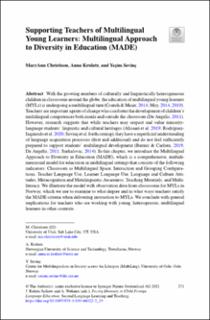| dc.description.abstract | With the growing numbers of culturally and linguistically heterogeneous children in classrooms around the globe, the education of multilingual young learners (MYLs) is undergoing a multilingual turn (Conteh & Meier, 2014; May, 2014, 2019). Teachers are important agents of change who can foster the development of children’s multilingual competences both inside and outside the classroom (De Angelis, 2011). However, research suggests that while teachers may respect and value minority-language students’ linguistic and cultural heritages (Alisaari et al. 2019; Rodríguez-Izquierdo et al. 2020; Sevinç et al. forthcoming), they have a superficial understanding of language acquisition processes (first and additional) and do not feel sufficiently prepared to support students’ multilingual development (Burner & Carlsen, 2019; De Angelis, 2011; Surkalovic, 2014). In this chapter, we introduce the Multilingual Approach to Diversity in Education (MADE), which is a comprehensive, multidimensional model for education in multilingual settings that consists of the following indicators: Classroom as Multilingual Space, Interaction and Grouping Configurations, Teacher Language Use, Learner Language Use, Language and Culture Attitudes, Metacognition and Metalinguistic Awareness, Teaching Materials, and Multiliteracy. We illustrate the model with observation data from classrooms for MYLs in Norway, which we use to examine to what degree and in what ways teachers satisfy the MADE criteria when delivering instruction to MYLs. We conclude with general implications for teachers who are working with young, heterogenous, multilingual learners in other contexts. | en_US |
